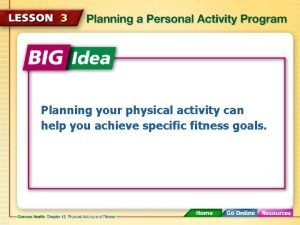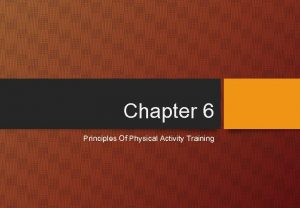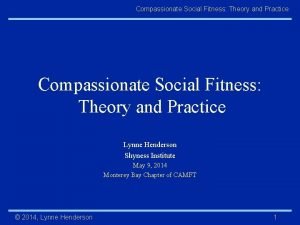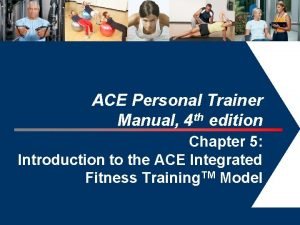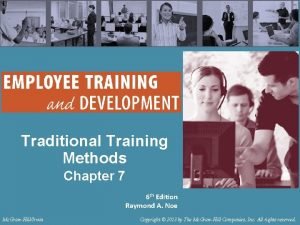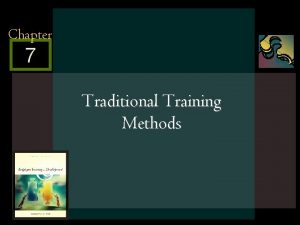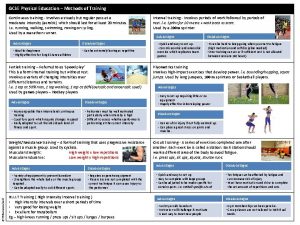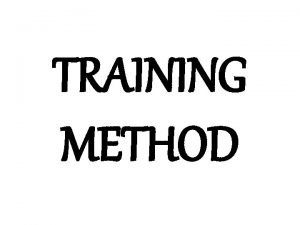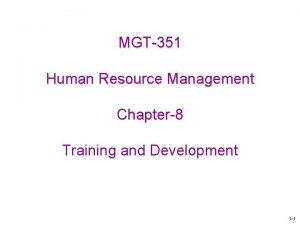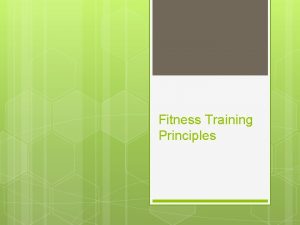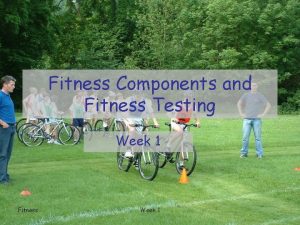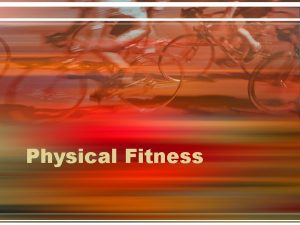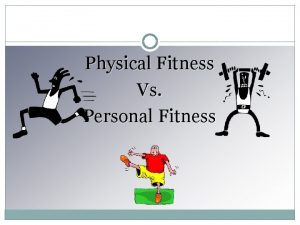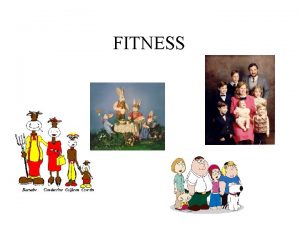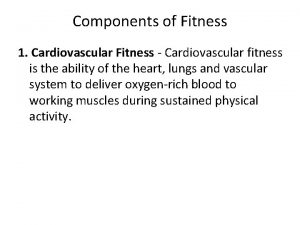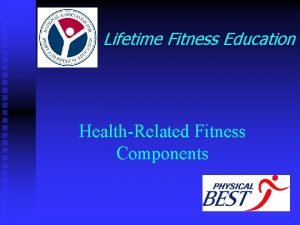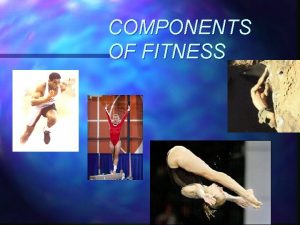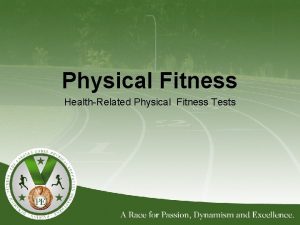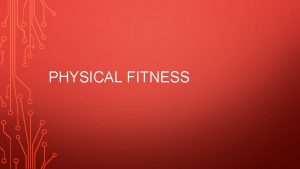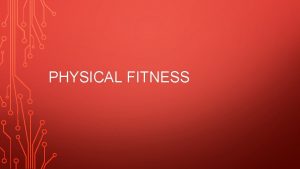Fitness Training Methods and Principles Principles of Training



















- Slides: 19

Fitness Training Methods and Principles

Principles of Training S- Specificity I- Intensity D- Duration O- Overload F- Frequency Minor Principles: Detraining Maintenance Individuality Diminishing returns Variety

Principles of Training - Specificity Forms the foundation of any training program to achieve maximal benefits Tailoring the program to the specific demands of an athlete’s sport/position Data collection and activity analysis is essential ENERGY SYSTEM USAGE Energy system usage should be identified for the activity and for each individual Enables appropriate training method to be selected Aerobic – continuous, fartlek or long interval training Anaerobic – short interval, medium interval, plyometrics W: R ratio must be considered

FITNESS COMPONENTS Dominant fitness components need to be identified Eg. Soccer goalkeeper v’s midfielder MAJOR MUSCLE GROUPS Need to be identified to ensure they are focused on during training Balanced training of muscle groups need to be maintained COMMON SKILLS It is becoming increasingly popular to blend skills sessions with physiological training to closer replicate the activity while developing fitness components

Principles of Training - Intensity Level of exertion applied during the work phase of training Critical in ensuring the targeted energy system and/or fitness component is being developed Methods of ascertaining and applying intensity: ◦ ◦ ◦ % HR max % VO 2 max Rate of perceived exertion Accelerometers GPS HR MONITORING Increases linearly with intensity until it reaches its maximum % HR measures intensity A more valid way of calculating max HR is max HR = 208 -0. 7 x age (years)

RATE OF PERCEIVED EXERTION (RPE) There is a delay before HR monitors show the actual HR For training that is of short duration (under 60 secs) and high intensity, the rate of perceived exertion may be a more accurate indicator of intensity. RPE is a person’s own perception of the training stress. RPE relies on the athlete assigning a numeric rating to their perception of exertion See table 10. 2 on page 268 of your textbook TRAINING ZONES To maximise chronic training adaptations it is essential to train at the correct intensity See table 10. 3 on page 269 of your textbook Aerobic adaptations: 70 – 85% max HR or RPE 3 – 6 Anaerobic adaptations: greater than 85% max HR or RPE 8 Weight control zone: 60 – 70% max HR Fat Burning zone: 50 – 60% max HR LIP occurs at a lower %age for untrained people Eg. For most people working at 87% max would elicit anaerobic adaptations, however, for a highly trained athlete their LIP may occur at 92% max HR. At 87% they would still be training their aerobic energy system. To train their anaerobic system they would need to work above 92% HR max.

Principles of Training - Duration Length of training program eg. 12 months Minimum time a training program needs to be performed before chronic adaptations occur The length of the actual training session eg. min of 20 mins to elicit aerobic adaptations The length of time of a bout of exercise during a training session eg. the length of work phase in interval training ◦ Aerobic adaptations: min 6 weeks (more likely 12 weeks) ◦ Anaerobic adaptations: 6 -8 weeks Periodisation: the planned variation in training methods, volume and intensity designed to bring about optimal performance at a specific time Organising training into manageable blocks or periods of time A structured approach to training will result in the greatest potential for improvement Build in tapering and peaking

Tapering: the reduction in training volume before competition. Minimises the effects of fatigue Peaking: the manipulation of training to ensure a performer is at their optimal physiological state before a competition Macrocycle: a long training program (usually 12 months) Mesocycle: segment of the macrocycle (usually 3 – 6 wks) Microcycle: smaller segment of a mesocycle (usually 7 days) Know and understand Figure 10. 4 on page 210 of your textbook Minimum duration for aerobic improvement is 6 weeks and can take up to 12 weeks, 3 -7 times per week, 70 -85% max HR For anaerobic improvements: 6 – 8 weeks of training produces noticeable improvement, 3 -5 times per week, 85 -100% max HR An individual should be in the ‘training zone’ for heart rate (70 -85% of max HR) for at least 30 mins in each training session and does not need to be continuous

Principles of Training – Progressive Overload The goal of any training program is to cause long term chronic adaptations to enhance performance Applying a new workload stimulus to a performer will cause stress and the body adapts to the new stressors Plateau: to reach a level or period where no change is observed. Therefore we need to apply progressive overload to training to ensure continuous positive adaptations How much overload to apply? One variable should be manipulated at a time and this overload should fall in the range of 2 – 10%. Overload beyond 10% may become too difficult and have reverse effects resulting in overtraining and performance setbacks. See Figure 10. 5 on page 271 of your textbook See Figures 10. 7 & 10. 8 on page 272 of your textbook

Principles of Training - Frequency • • To improve a fitness component, training for that component must occur at least 3 times per week. Rest and recovery are important considerations that need to be build into your training program As a general rule 3 sessions per week is considered the minimum for achieving aerobic fitness gains. 5 sessions per week is considered ‘normal’ As an athletes fitness improves, they can increase the frequency of training. For example – Steve Moneghetti trains 6/7 days per week and sometimes twice per day. Minimum frequency for improving anaerobic fitness, including strength and power is 3 or 4 sessions per week. The nature and intensity of this type of activity means muscle recovery is an important factor. Fewer sessions are advised for beginners, means the beginner has a better chance of sustaining the program and minimising injury.

Catabolic effect: the destructive metabolism (breakdown) of muscle tissue and other compounds in the body Anabolic effect: the building of proteins and muscle tissue. Repair and ultimately the chronic adaptations Without sufficient rest, positive anabolic effects will be greatly reduced When a performer becomes accustomed to their training program, frequency may be increased Split routines: when different body parts are trained on different days Read ‘Real World Focus’ on pg 273 -274 of your textbook

Principles of Training - Detraining Also known as ‘reverseability’ Termination of training that results in a rapid return to pre-training levels Possibly due to: illness, injury, boredom or a poorly planned training program The effects of aerobic detraining are almost immediate. VO 2 max can decrease by 8% in 3 wks and 18% in 12 wks Occurs faster for those with immobilisation injuries Principles of Training - Maintenance Fitness gains can be maintained by training twice per week Popular for seasonal sports

Principles of Training - Individuality Individuals respond differently to a similar training stimulus. Why? Genetic Predisposition Fibre type makeup Individual fitness levels Performers with little exposure to training methods may need to start with a reduced volume of training to avoid fatigue Preparedness Returning from injury may find it causes excessive fatigue Adaptive Response Different people adapt to activities at different levels Training programs must be tailored to the individual’s needs

Principles of Training – Diminishing Returns An untrained individual will show greater initial improvements As a performer gets closer to their ultimate potential, the rate of improvement significantly slows down See figure 10. 12 on pg 277 of your textbook Principles of Training – Variety Varying a program helps to mentally reinvigorate a performer who is becoming bored with a program It is essential to remember specificity when considering adding variation to a training program

Planning a Training Program The purpose of any training program is to facilitate chronic adaptations in the desired fitness components, energy systems and muscle groups A ‘Needs Analysis’ should be completed to determine: Energy systems, fitness components and muscle groups Fitness test results for the performer: Strengths and weaknesses Availability of time Appropriate training program: access to facilities Physical state of the performer: Injuries

Designing a training session Sequencing is paramount to ensuring the best possible outcomes Warm-up • Physiologically and psychologically prepares the performer • Focus on upcoming work period • Increase arousal • Usually lasts around 8 – 10 mins • After 4 – 5 mins activity should become more specific • The jury is out regarding static stretching during a warm-up Cool-down • Perform the same locomotion at a reduced intensity (active recovery) • Best time for stretching

Training Logs • Maintaining a training log before and after training can provide invaluable info to the performer QUESTIONS: • Define each of the principles of training (SIDOF). • What is the best way of determining training intensity? • Give the recommended HR training zone for training aerobic power. • Give the recommended HR training zone for training anaerobic power. • Give the recommended HR training zone for training ATP-PC energy. • What is the minimum time in which the HR should be in the required zone for aerobic training? • What is generally recognised as the minimum number of weeks for a training program to show measurable fitness gains? • Why should there be more recovery between anaerobic training sessions than between aerobic training sessions? • What are the variables with which training programs can be overloaded?

Methods of Training Interval Training Continuous Training Fartlek Training Resistance Training Speed Training Plyometrics Training Circuit Training Core-Strength Training Flexibility Training

Method Fitness Components Interval Training Cardio-respiratory endurance, Muscular Power, Anaerobic Power/speed, LME Continuous Training Cardio-respiratory endurance, LME Fartlek Training Cardio-respiratory endurance, LME, anaerobic power/speed Circuit Training Cardio-respiratory endurance, strength, power, dynamic flexibility, agility, LME Plyometric Training Power, speed, strength, dynamic flexibiltiy, agility, LME Flexibility Training Static and dynamic flexibilty Weight Training Strength, Power, speed and LME Speed Training Speed, Muscular power, Strength, LME Pilates & Swiss Ball Balance, Coordination, Flexibility, LME Motor Skill Development Requires effective integrations of all components
 Skill and health related
Skill and health related Inlay wax pattern fabrication
Inlay wax pattern fabrication What are the four principles of building fitness
What are the four principles of building fitness 6 principles of fitness
6 principles of fitness Inductive method
Inductive method Social fitness training
Social fitness training Ace ift model
Ace ift model Principles of training individuality
Principles of training individuality Traditional training methods advantages and disadvantages
Traditional training methods advantages and disadvantages Principle of cooking
Principle of cooking Means to cook with radiant heat from above
Means to cook with radiant heat from above Traditional training methods
Traditional training methods Disadvantages of interval training gcse pe
Disadvantages of interval training gcse pe Circuit training methods
Circuit training methods 5 disadvantages of circuit training
5 disadvantages of circuit training Methods of training in human resource management
Methods of training in human resource management Methods of training
Methods of training Employee training methods
Employee training methods Programmed instruction
Programmed instruction 6 principle of training
6 principle of training


